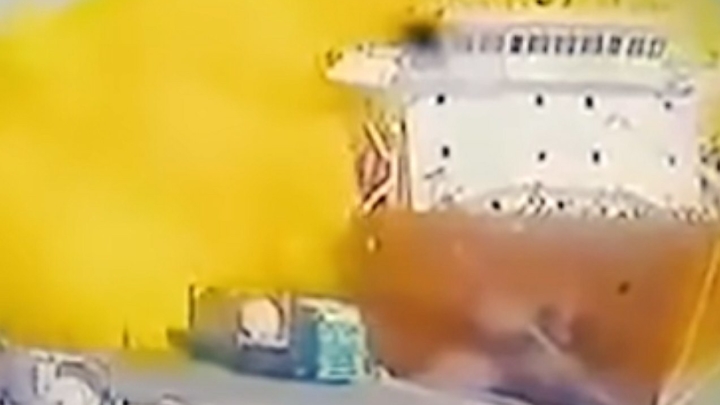
The incident happened on Monday 27 June as tank containers charged with liquefied chlorine were being loaded onto the MV Forest 6. Thirteen people died and about 250 were injured.
Jordan’s Minister of Interior Mazen Al-Faraya was quoted in local media saying that the direct cause of the accident was “an overburdened cable” being used on the crane that was loading the tank containers. The tank that fell when the cable failed was three times heavier than the carrying capacity of the cable, the minister said at a press conference.
The investigation into the incident has been referred to the Public Prosecutor.
At least 20 tonnes of chlorine escaped when the cable snapped. The force of the fall ruptured the pressurised container, enveloping the vessel in a bright yellow gas.
The minister said that an initial investigation had proved that safety measures for handling dangerous materials at Aqaba had been ignored.
Faraya said that the Cabinet had approved the firing of the directors general of the Jordanian Maritime Authority and the Aqaba Company for Ports Operation and Management, as well as a number of other officials at the company.
The Cabinet also dissolved the Aqaba Company for Ports Operation and Management’s board of directors, which will be reconstituted at a later date.
“The investigation proved the responsibility of the general manager of the Aqaba Company for Ports Operation and Management, the director of the company’s operations department, the head of the unloading and loading department, the head of the unloading and loading shift, and the captain of the ship at the time of the accident, among others,” Faraya was quoted as saying.
Investigators also determined that certain tasks had been assigned to insufficiently trained staff.
Investigation goals
The investigation committee sought to achieve three goals, according to the minister. First, to establish the truth behind the events; second, identify any negligent parties and recommend appropriate punishments; and third, identify weaknesses in the system and present recommendations to address them, according to Faraya.
Additionally, the committee sought to reassure the public that the state was tackling the issue seriously to prevent similar incidents in the future, he said.
Furthermore, the Department of Criminal Evidence and Laboratories submitted a technical report on the incident.
CCTV images show the moment when the tank dropped, followed by the gas release. They also show the tank being lifted with a sling system under the crane hook, rather than a dedicated container spreader; the latter being considered as much safer for handling any type of ISO container.
A representative of the chemical and cosmetic industries sector in the Jordan Chamber of Industry, Engineer Ahmed Al-Biss, told the state-run Jordan News Agency (Petra) that chlorine gas is essential for various uses, especially for sterilisation of drinking water.
“Chlorine is used in the chemical, petrochemical and organic industries, mostly for health and sterilisation purposes for toilets in cooling and heating towers, as well as in household cleaning materials,” he was quoted as saying.
Chlorine is twice as heavy as air, so when tank ruptured the gas spread laterally staying close to the ground, creating a cloud with a fatal concentration of the gas. During the First World War chlorine gas was even as a chemical weapon.
Safety concerns
The Union of Port Workers told The New Arab that the union had previously raised concerns about safety to the Aqaba Port Company (APC), but said their concerns went unaddressed.
These included better standards when dealing with hazardous materials, replacing old, worn-out equipment, and confining hazardous materials to a special section of the port.
In 2005, a similar incident occurred in Graniteville, South Carolina, when a freight train carrying three 90-ton rail tank wagons of chlorine collided with a parked locomotive in a marshalling yard. One of the tanks ruptured releasing more than 40 tons of chlorine. Seven people were killed and more than 70 were injured.